Analysis of Typical Mining Family Series 1——Outlaw Mining Botnet
The original report is in Chinese, and this version is an AI-translated edition.
1.Introduction
With the rise of blockchain technology and virtual currencies such as cryptocurrencies in recent years, the open source of mining Trojans has led to a decrease in the cost of obtaining mining Trojans. A large number of black market organizations continue to operate mining Trojans, and many other black market organizations have turned their attention to the virtual currency market, resulting in the continued activity of mining Trojans. In the second half of 2021, the state issued a notice to rectify virtual currency “mining” activities, clearly requiring the rectification of virtual currency mining activities, and cracking down on mining activities has become imperative. During this year, the mining rectification activities have achieved significant results, and the number of mining Trojans in government enterprises and universities has continued to decrease. Although the cryptocurrency market this year is not as good as in previous years, mining Trojans are still profitable, and many small mining Trojan families will still emerge in 2022. For example, mining Trojan families such as Hezb [1] , “1337 [2] ” and Kthmimu [3] .
Antiy CERT has compiled a special report on the typical popular mining Trojan families it has tracked over the past few years, which will be released sequentially over the next few months. The report will also continue to track new popular mining families. This report will detail the historical evolution of mining Trojan families, analyze family sample iterations, review historical attack incidents, provide post-infection troubleshooting methods, and disclose additional indicators of compromise (IoCs). Furthermore, we will continue to improve our security product capabilities and implement effective technical solutions to detect and remove mining Trojans, helping government and enterprise organizations effectively protect against and eliminate them.
In recent years, Antiy has published more than ten analysis reports on mining Trojans. Next, we will conduct targeted analysis and form reports on the four mining families: TeamTNT, LemonDuck, GuardMine, and Sysrv -hello.

Figure 1 Popular mining family history releases and upcoming releases
2.Introduction to Mining Trojans
2.1 What is Mining?
Mining refers to the process of obtaining virtual currency by executing proof-of-work or other similar computer algorithms. “Mine” represents the virtual currency, and the workers who mine are usually called miners. Mining Trojans, on the other hand, use various means to implant mining programs into victims’ computers. Without the user’s knowledge, they exploit the victim’s computing power to mine, generating illegal profits. These mining programs that illegally intrude on users’ computers are called mining Trojans.
There are two types of mining: solo (connecting directly to a central network), where all profits belong to the individual; and pooled (connecting to a mining pool), where profits are shared with the pool. Mining trojans often use this method due to its relatively low technical difficulty and relatively stable returns. There are also two types of mining: passive mining, where a mining program is implanted without the user’s knowledge, and the resulting virtual currency belongs to the intruder who implanted it. Active mining, where a user actively uses computing assets to run the mining program, and the resulting virtual currency belongs to the owner or user of the computing assets. Mining essentially involves calculating and returning a matching hash value, using a brute-force method that consumes host resources and wastes user battery life.
2.2 Why Is Mining Activity Becoming Increasingly Popular?
Comparing this with the equally prevalent ransomware campaign reveals that mining revenue is more stable than ransomware. In ransomware incidents, it’s difficult to pinpoint hosts that have encrypted important content, while users can’t guarantee decryption services after paying the ransom. This results in a significant disparity between the scale of ransomware campaigns and the ransoms collected .
In mining, simply running the program on a computer earns shares in the mining pool (depending on the pool’s distribution model) and converts them into profits. Mining is also less difficult than ransomware, and most operations utilize open-source programs and register a wallet address, allowing users to sit back and reap the rewards without any additional effort.
The value-added and anonymity of virtual currencies also contribute to the rise of mining trojans. Using virtual currencies not only allows users to evade real-world financial investigations but also provides access to potentially valuable currency, effectively killing two birds with one stone. This is why mining trojans favor anonymous currencies, such as Monero.
2.3 The Dangers of Mining Trojans
Victims often assume that mining Trojans simply cause system freezes and pose no significant threat to their own health. However, beyond simply freezing the system, mining Trojans can also reduce computer performance and lifespan, harming business operations and wasting energy. Furthermore, mining Trojans often include backdoors, creating a botnet for attackers to exploit, launching attacks against other computers. Therefore, mining Trojans are no longer simply about mining; they are increasingly being used to generate profits.
3.Overview of the Outlaw Mining Botnet
The Outlaw mining botnet was first discovered in 2018. It mainly targets cloud servers for mining activities and remains active. It is suspected to be from Romania and was first named Outlaw by Trend Micro[6], which means “death man” in Chinese. When the mining botnet was first discovered, the attacker used a backdoor program in the Perl language to build a robot, so it was named “Shellbot”. Its main propagation method is to write the SSH public key to the target system through SSH brute force attack in order to achieve the purpose of long-term control of the target system, and at the same time download the backdoor written in the Perl script language and the open source Monero mining Trojan. The backdoor component written in the Perl language can launch DDoS attacks and use the botnet to make profits through DDoS services and mining programs. For example, in July 2021[7], the Outlaw botnet attacked a large number of cloud hosts and implanted botnet programs. There were a large number of SSH brute force cracking records in the infected hosts, and mining programs were implanted and SSH public keys were written.
The Outlaw botnet was distributed in 2018 using the Shellshock vulnerability and SSH brute-force attacks. The Shellbot backdoor program exploited common command injection vulnerabilities on IoT devices and Linux servers to infect systems. Since 2019, it has exclusively used SSH brute force attacks for distribution. Outlaw uses SSH brute force attacks to access target systems and download a TAR archive containing a Shell script, a mining trojan, and a backdoor. It then executes remote commands to download and execute malicious programs. Monitoring of this mining group in 2022 indicates continued activity, primarily targeting cloud servers.
4.Outlaw Organization Introduction
The Outlaw botnet was first discovered in November 2018. At the time , the attackers behind it were a group that exploited vulnerabilities in IoT devices and Linux servers and implanted malicious programs to build a botnet. They primarily engaged in DDoS attacks and provided DDoS- for-hire services on the dark web. Later, driven by the appreciation of virtual currencies, they began to embed mining trojans within the botnet nodes. They then used the botnet to infiltrate and expand externally, acquiring more computing resources and ultimately obtaining more virtual currency through mining.
Table 4‑1 Outlaw botnet information
| Organization name | Outlaw |
| Organization introduction | A botnet formed by spreading the Perl-based Shellbot through vulnerability exploitation and SSH brute-force attacks later began deploying cryptocurrency mining malware for profit. |
| First disclosure time | November 1, 2018 |
| First disclosure of manufacturers | Trend Micro |
| Country of origin | Suspected Romania |
| Reason for naming | Derived from the Romanian word haiduc, the hacking tool used by the group is Haiduc |
| Threat type | Botnets and mining Trojans |
| Target | Linux, IOT |
| Transmission routes | Shellshock (CVE-2014-7169) vulnerability, Drupalgeddon2 vulnerability (CVE-2018-7600) vulnerability and SSH brute force cracking, mainly using the latter, the vulnerability exploitation was only used in the early stage |
| Organizational components | Hidden process tool (XHide), SSH brute force tools (Haiduc, ps, tsm), Shellbot program, mining trojan (Xmrig) |
| Version iteration | This botnet sample has 5 versions, the main differences are the addition of new functions, replacement of cracking tools, and changes in the functions of cracking tools. |
During analysis, we found that Outlaw had significant characteristics after updating its attack components. For example, the parent file names were “dota.tar.gz”, “dota2.tar.gz”, and “dota3.tar.gz”, so we named them version 1, version 2, and version 3. Prior to version 1, we also discovered two update activity signatures, which we named version 0 and version 0 variant.
The Outlaw group first appeared in version 0 and subsequent variants in November 2018. They exploited the Shellshock (CVE-2014-7169) and Drupalgeddon2 (CVE-2018-7600) vulnerabilities, as well as SSH brute force attacks. Their attack weapons included the proprietary backdoor Shellbot, the scanning and brute force tool Haiduc, and the hidden process tool XHide. They primarily targeted Linux and a small number of IoT devices, releasing mining programs to mine Ethereum and Monero. The first version appeared in March 2019, primarily using SSH brute force attacks. Their attack weapons included the proprietary backdoor Shellbot and the scanning and brute force tool TSM, targeting Linux and IoT devices. The second version appeared in June 2019. This version had a short lifespan and low usability. During analysis, many scripts failed to execute successfully, leading to speculation that this version was likely a test version. Aside from using PS as the scanning and blasting tool, everything else was identical to the first version. From July 2020 to the present, attacks have been conducted using the third version. This version is feature-rich and offers a comprehensive tool set. After several iterations, it has become highly mature and is the longest-lived version to date. Its tools and propagation methods remain unchanged from previous versions.
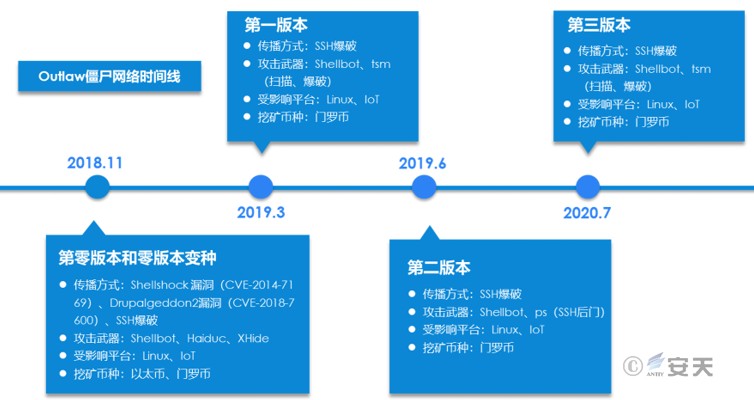
Figure 4 ‑1 Outlaw (variants/development) timeline
5.ATT&CK Mapping Diagram Corresponding to the Incident
The attacker deployed a mining Trojan to the target system. The ATT&CK mapping diagram corresponding to this attack incident is shown in Figure 5-1.
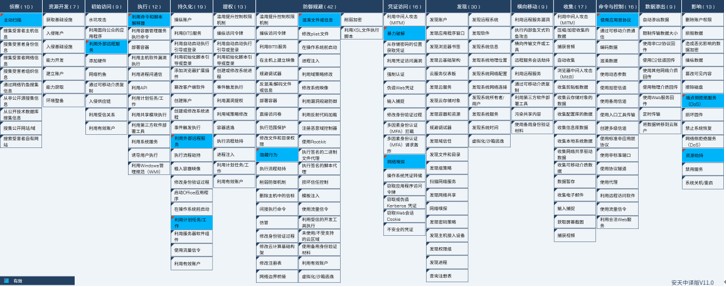
Figure 5 ‑1 ATT&CK mapping diagram corresponding to the incident
The techniques used by the attacker are shown in Table 5‑1.
Table 5 ‑1 Description of the corresponding ATT&CK technique and behavior for the incident
| ATT&CK stage/category | Specific behavior | Notes |
| Reconnaissance | Active scan | Scan 22 ports |
| Initial access | Leverage external remote access | Remote access using SSH |
| Execute | Utilize command and script interpreters | Use shell scripts |
| Persistence | Leverage external remote services | Use SSH public key persistence |
| Use scheduled tasks | Create a scheduled task | |
| Defense evasion | Obfuscate files or information | Obfuscate files using base 64 |
| Hidden behavior | Use the hide tool to hide the process | |
| Credential access | Brute force | SSH blasting |
| Network sniffing | Scan specific ports | |
| Command and Control | Use application layer protocols | Transmit using IRC protocol |
| Influence | Endpoint-side Denial of Service (DoS) | Shellbot command can launch DDoS attack |
| Resource hijacking | Occupies CPU resources |
6.Protection Recommendations
Antiy recommends that companies take the following protective measures against illegal mining:
- Windows/Linux version of Antiy Intelligent Endpoint Protection System;
- Strengthen SSH passwords: Avoid using weak passwords. It is recommended to use passwords that are 16 characters or longer, including a combination of uppercase and lowercase letters, numbers, and symbols. Also, avoid using the same password on multiple servers.
- Update patches in a timely manner: It is recommended to enable the automatic update function to install system patches, and the server should update system patches in a timely manner;
- Update third-party application patches in a timely manner: It is recommended to update third-party application patches such as WebLogic in a timely manner;
- Enable logs: Enable key log collection functions (security logs, system logs, error logs, access logs, transmission logs, and cookie logs) to provide a basis for tracing security incidents.
- Host reinforcement: perform penetration testing and security reinforcement on the system;
- Deploy an intrusion detection system (IDS): Deploy traffic monitoring software or equipment to facilitate the discovery and tracing of malicious code. Antiy Persistent Threat Detection System (PTD) uses network traffic as the detection and analysis object, and can accurately detect a large amount of known malicious code and network attack activities, and effectively discover suspicious network behaviors, assets and various unknown threats;
- Antiy Service: If you are attacked by malware, it is recommended to isolate the attacked host in a timely manner and protect the site while waiting for security engineers to investigate the computer; Antiy 7*24 hour service hotline: 400-840-9234.
It has been verified that Antiy Intelligent Endpoint Protection System (IEP) can effectively detect and eliminate the mining botnet.
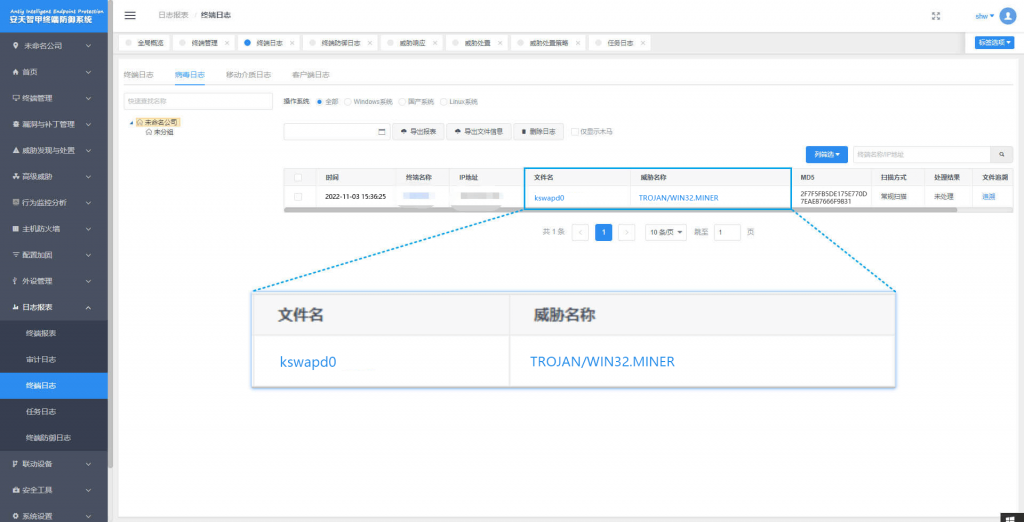
Figure 6 ‑1 Antiy IEP achieves effective protection for users
7.Sample Analysis
After the target system is brute-forced by SSH, the attacker will download a compressed file named “dota3.tar.gz” from the hosting website. The file structure is as follows: the open source Monero mining program kswapd0 (xmrig) and startup script are stored in the folder named “a”, the backdoor program run and execution script are stored in the folder named “b”, and the SSH brute-force cracking and scanning tools are stored in the folder named “c” .
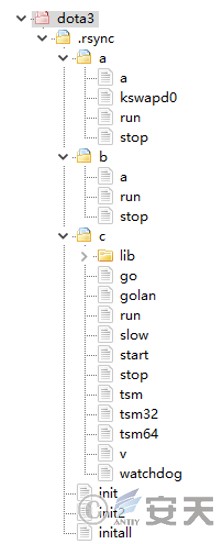
Figure 7 ‑1 Sample directory structure
7.1 a Folder
7.1.1 End the Competing Process — stop File
Terminate the competing mining processes of cron, kswapd0, ld-linux, Donald, xmr, and xm 64, save the results in the proc hidden file, and finally delete the proc file.
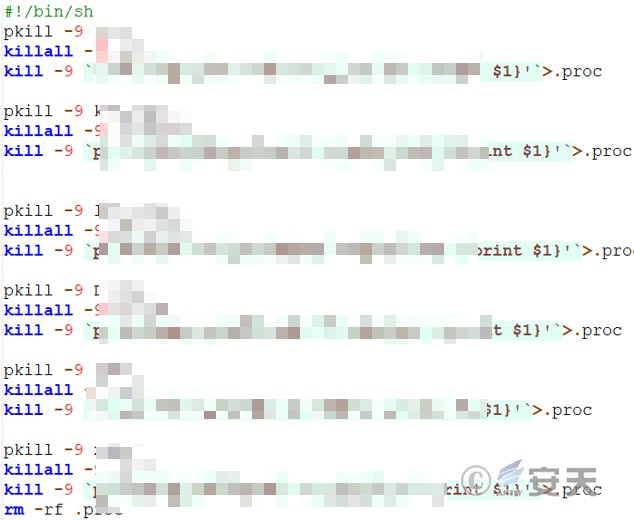
Figure 7 ‑2 End the competition
7.1.2 Determine the System Architecture – run File
Execute the stop script, sleep for 10 seconds, list the current working path and output it to the file dir.dir, list the current computer system architecture, if it is i686, suspend the backend, if it is x86_64, execute the kswapd0 mining program, and write the PID of the last running background process to a .pid file.

Figure 7 ‑3 Determine the system architecture
7.1.3 View CPU Information – a File
Search for all node * directories under /sys/devices/system/node/ and output $i/hugepages/hugepages-1048576kB/nr_hugepages to check CPU information. If it’s an AMD Ryzen processor, output “Detected Ryzen”, add register values, and output “MSR register values for Ryzen applied”. If it’s Intel, output “Detected Intel”, add register values, and output “MSR register values for Intel applied”. Otherwise, output “No supported CPU detected”. Grant permissions to upd and execute the upd script.
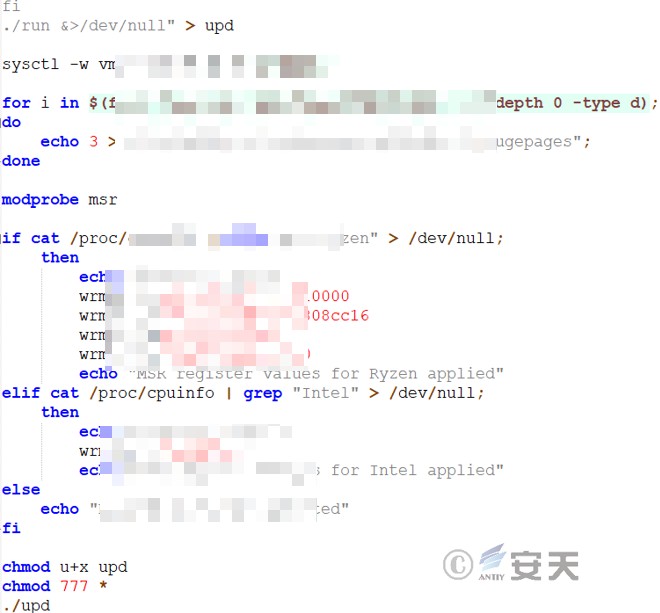
Figure 7 ‑4 Check CPU information
7.1.4 Mining Program — kswapd0 File
After checking, it was found that the mining program was the open source Monero mining program xmrig, version 6.6.2.
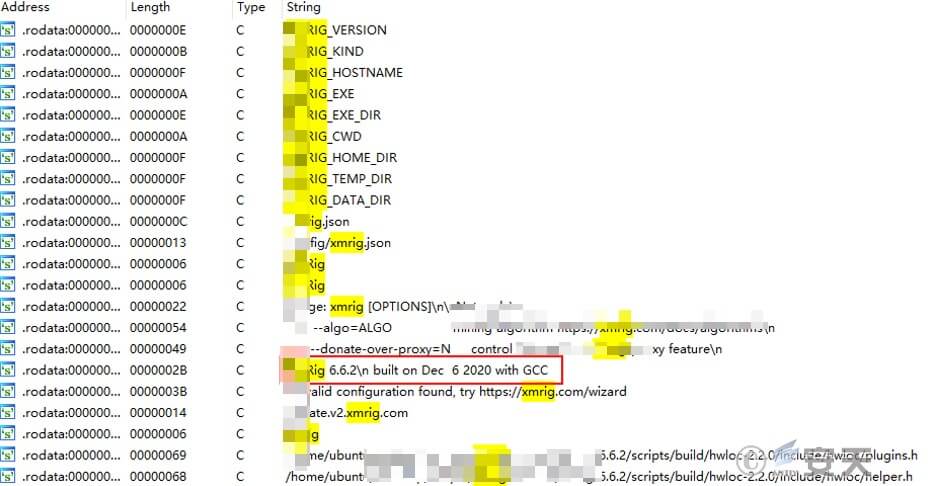
Figure 7 ‑5 xmrig mining program
Since the mining program’s configuration file has not yet been found, it is initially suspected that the attacker hard-coded the code into the mining program. While reviewing the code, the configuration file information was discovered, which included information such as the mining pool address, currency, and wallet address.
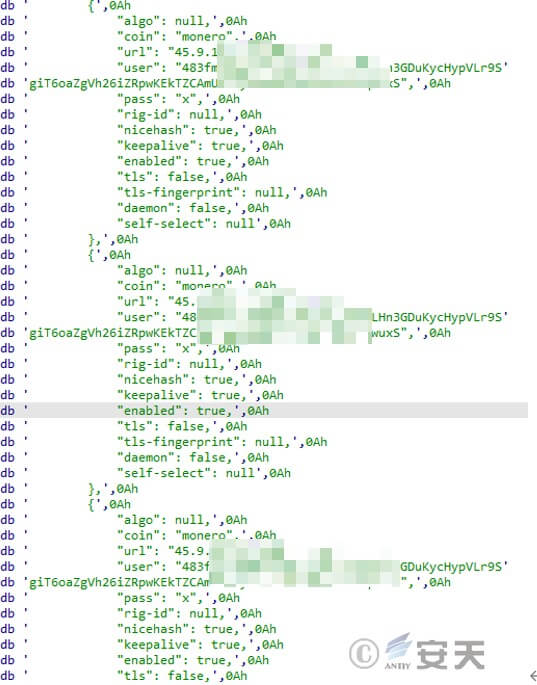
Figure 7 ‑6 Mining configuration file
Table 7 ‑1 Mining pool address and wallet address in the mining program
| Mining pool address | Wallet address |
| 45.9.148.117:80 | 483fmPjXwX75xmkaJ3dm4vVGWZLHn3GDuKycHypVLr9SgiT6oaZgVh26iZRpwKEkTZCAmUS8tykuwUorM3zGtWxPBFqwuxS |
| 45.9.148.117:443 | |
| 45.9.148.129:80 | |
| 45.9.148.129:443 | |
| 45.9.148.125:80 | |
| 45.9.148.125:443 | |
| 45.9.148.58:80 | |
| 45.9.148.58:443 | |
| 45.9.148.59:80 | |
| 45.9.148.59:443 |
7.2 b Folder
7.2.1 Execute Subsequent Scripts – a File
Grant permissions to all scripts in directory a and execute them.

Figure 7 ‑7 Execute script program
7.2.2 IRC Backdoor Program – run File
The output field is a base 64 -encoded Perl language, and the SSH public key is added at the end to achieve the purpose of long-term control of the target system.

Figure 7 ‑8 Add SSH public key
It is found that the Perl language is obfuscated and needs to be output to print out the decrypted code.

Figure 7 ‑9 Perl language obfuscated code
After decoding, it is a standard Perl code. Due to the large amount of code, the important parts are analyzed below. First, a series of variables are defined, such as the process name rsync, the C2 server 45.9.148.99, and the port number 443.
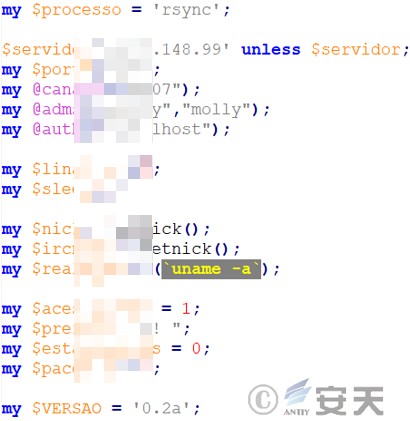
Figure 7 ‑10 Define variable information
Port scanning function code is shown below.
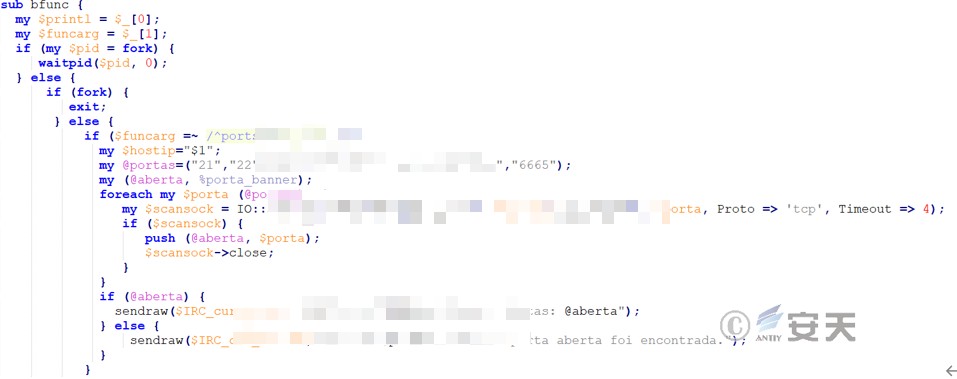
Figure 7 ‑11 Port Scan
The DDoS attack code is shown below.
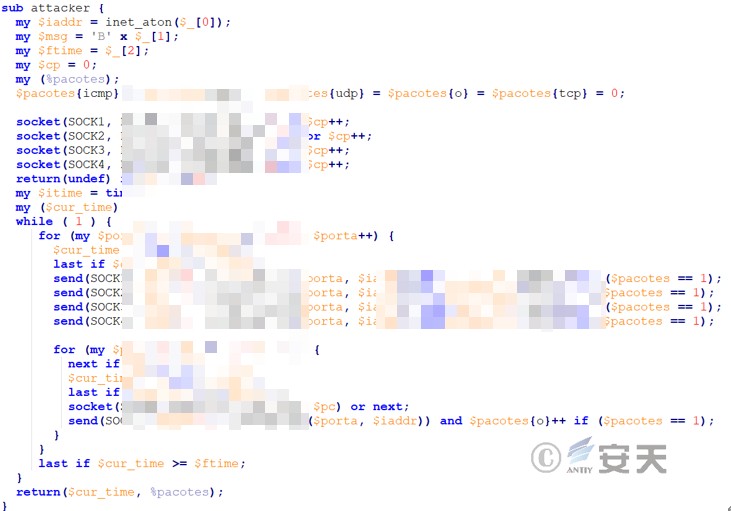
Figure 7‑12 DDoS attack
7.2.3 End the Competing Process — stop File
Terminate the competing processes rsync, sync, perl, ps, pool, nginx, ecryptfs, and xmr, output the results to the hidden file out, and finally delete out.
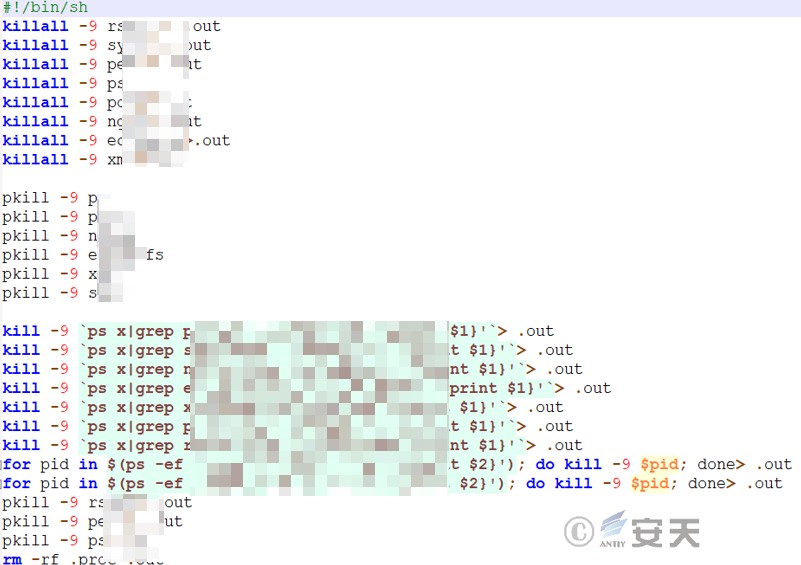
Figure 7 ‑13 End the competition
7.2.4 Blasting and Scanning Tools — c Folder
The c folder contains multiple scripts, whose functions are similar to those of the files in the a and b folders. The main analysis is the lib file in the c folder, which contains the tsm blasting and scanning tool that supports 32- bit and 64- bit.
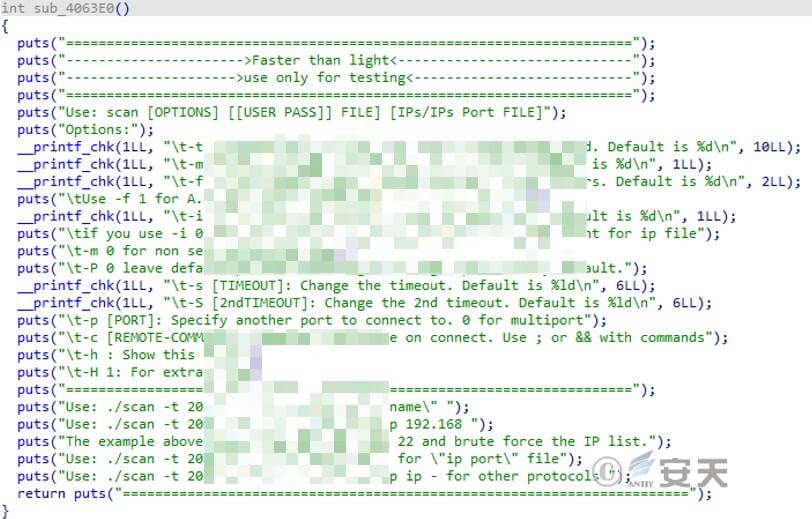
Figure 7 ‑14 Scan information
Execute the tool to see the relevant parameters.
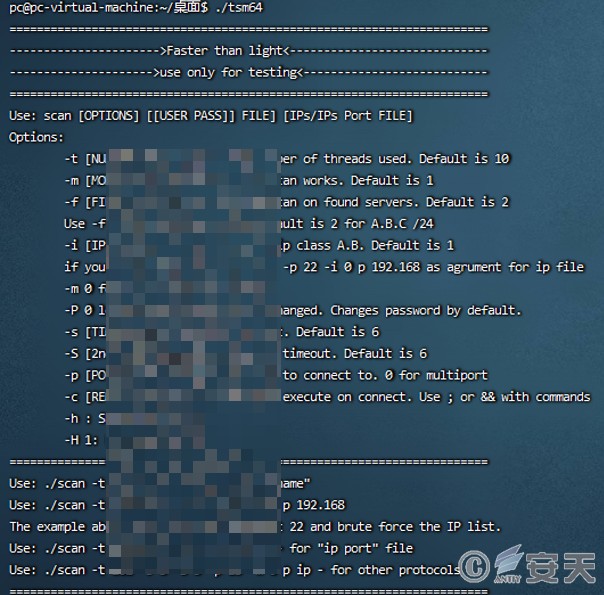
Figure 7 ‑15 Corresponding parameters
3 external IPs in the tool.
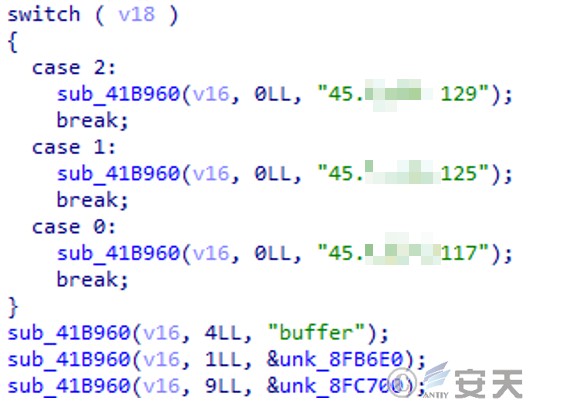
Figure 7 ‑16 External IP
8.Comparison of Modules in Different Versions
8.1 Parent file
Table 8 ‑1 Comparison of features of each version
| Sample description | Version 0 features | Version 0 variant features | Features of the first version | Features of the second version | Features of the third version |
| Parent file name | n.tgz | sslm.tgz eth.tgz monero.tgz | dota.tar.gz | dota2.tar.gz | dota3.tar.gz |
| Hidden process tool | hide | hide | none | none | none |
| Blasting tools | none | haiduc | tsm | ps | tsm |
| Shell Bot | n3 | Special PHP script implementation | rsync | rsync | rsync |
| Mining program | cnrig | Ethminer XMRigCC | XMRig | XMRig | XMRig |
| Mining pool address | 54.37.75.69:3333 | pool.supportxmr.com:5555 | 5.255.85.210:80 | 5.255.86.129:80 107.191.99.221:80 workforce.ignorelist.com | 45.9.148.117 45.9.148.129 45.9.148.125 45.9.148.58 45.9.148.59 |
| Wallet address | Sumoo77E8WSehFNJyMcevHWKkwq6cr3Bobi5p81cUSyv9GcKfHG3ReQU6mrhfMqwup9KccDuSMxiLET9va7diNdwFZfbexNKTJE | 42hhyPKkombM6LYEsz6kZe3d1ktHpkkD54Rtv5VZohaAbQAXzmAjkHSDZVWqMm9ieRCjMkijBYhy39ZJrYWVxKDVVqtzwPf | 481fnPjXvX75xmkaJ3dm4vVGWZLHn3GDuKycHypVLr9SgiT6oaYgVh26iZRpwKEkTZCAmUS8tykuwUorM3zGtWxPBFquwuS | 45UcbvLNayefqNad3tGpHKPzviQUYHF1mCapMhgRuiiAJPYX4KyRCVg9veTmckPN7bDebx51LCuDQYyhFgVbUMhc4qY14CQ | 483fmPjXwX75xmkaJ3dm4vVGWZLHn3GDuKycHypVLr9SgiT6oaZgVh26iZRpwKEkTZCAmUS8tykuwUorM3zGtWxPBFqwuxS |
8.2 Shellbot
Table 8 ‑2 Shellbot features by version
| Sample name | Function |
| Version 0 (n3) | Perl script , the botnet functionality is clear, without any obfuscation, and separated from the parent file |
| Special form bot | The second generation botnet program uses PHP scripts and is divided into two parts: the PHP script delivered to the target and the PHP webpage hosted on the relevant domain name (with functions such as infection target record, account password dictionary replacement, target IP replacement, and related script command replacement). |
| First version (rsync) | Perl script , the botnet functionality is clear, without any obfuscation, and separated from the parent file |
| Second version (rsync) | Obfuscated perl script |
| Version 3 (run) | Obfuscated perl script is base64 encoded and must be decoded and imported into perl for execution. |
8.3 Mining Module
Table 8 ‑3 Sort out various versions of mining programs
| Version | Mining program |
| Version 0 | cnrig |
| Version 0 variant | Ethminer(6.4.0)、XMRigCC(2.5.2) |
| First version | XMRig-AMD(2.8.6)、XMRig(2.12.0) 64-bit and 32-bit , XMRig-NVIDIA (2.8.4) |
| Second version | XMRig(2.14.1)32-bit and 64-bit |
| Third version | XMRig(6.6.2) |
8.4 Blasting Module
Table 8‑4 Sorting of blasting tools in various versions
| Version | Blasting module |
| Version 0 | No brute force module, but uses vulnerabilities to spread, such as CVE-2017-1000117 |
| Version 0 variant | Haiduc with UPX shell |
| First version | tsm32/tsm64 (banner: BlitzBrute-Multithreaded SSH bruteforce tool v3.1 Xport – 2019) has a suspected C2 address : 5.255.86.129 |
| Second version | There is a suspected C2 address in the SSH public key replaced after the successful blasting of ps: 5.255.86.129 |
| Third version | The tsm32/tsm64 in ps contains the SSH public key to be replaced after successful blasting, and a script to execute base64 encoding. The script content is to decompress and execute the files in dota3.tar.gz. Suspected C2 address: 5.255.86.129 |
9.Self-Inspection and Removal
9.1 Self-Inspection Method
- Check /root/.configrc/* for virus samples;
- Check whether the public key in /root/.ssh/ is consistent with the report;
- Check the cache files in /tmp/.X25-unix/.rsync/* where the virus runs;
- Check whether the virus matrix file exists in /tmp/.X25-unix/dota3.tar.gz;
- Check /root/.configrc/a/kswapd0 for the presence of a virus main program;
- Check whether there is a scheduled execution of the above file in the scheduled task.
9.2 Removal Plan
1.Delete the following files and end the corresponding process
/tmp/*-unix/.rsync/a/kswapd0
*/.configrc/a/kswapd0
/tmp/*-unix/.rsync/c/tsm64
/tmp/*-unix/.rsync/c/tsm32
/tmp/*-unix/.rsync/b/run(rsync)
*/.configrc/
2.Check whether there are scheduled tasks containing the following content in cron.d. If so, delete them:
/a/upd
/b/sync
/c/aptitude
10.IoCs
| IoCs |
| URL |
| hxxp://54.37.72.170/n3|2018-11-14 |
| hxxp://54.37.72.170/n.tgz |
| hxxps://54.37.72.170/ |
| hxxp://54.37.72.170/n.tgz;tar |
| hxxp://54.37.72.170/n3 |
| hxxp://54.37.72.170/n3;perl |
| hxxp://54.37.72.170/ |
| hxxp://54.37.72.170/l.db |
| hxxp://54.37.72.170/n3|2018-11-11 |
| hxxp://54.37.72.170/n |
| hxxp://67.205.129.169/.foo/min.sh |
| hxxp://67.205.129.169/.foo/sslm.tgz |
| hxxp://67.205.129.169/.foo/xmstak.tgz |
| hxxp://67.205.129.169/.foo/ryo.tgz |
| hxxp://67.205.129.169/.foo |
| hxxp://67.205.129.169/.foo/monero.tgz |
| hxxp://67.205.129.169/ |
| hxxps://67.205.129.169/ |
| hxxp://karaibe.us/ |
| hxxp://karaibe.us/.foo/remote/info.php. |
| hxxp://5.255.86.129/abc |
| hxxp://5.255.86.129/minloc.sh |
| hxxp://5.255.86.129/lan.sh |
| hxxp://5.255.86.129/ml.tar.gz |
| hxxp://5.255.86.129/dota.tar.gz |
| hxxp://5.255.86.129/sslm.tar.gz |
| hxxp://5.255.86.129/rsync2 |
| hxxp://5.255.86.129/ |
| hxxp://zergbase.mooo.com/hello |
| hxxp://zergbase.mooo.com/ |
| hxxp://5.255.86.125/ |
| hxxps://5.255.86.125/ |
| hxxp://45.9.148.99/favicon.ico |
| hxxps://45.9.148.99/rsync |
| hxxp://debian-package.center/ |
| hxxp://www.debian-package.center/ |
| hxxp://45.9.148.129/dota3.tar.gz |
| hxxp://debian-package.center/ |
| hxxp://159.203.85.196/dota3.tar.gz |
| hxxp://138.68.115.96/dota3.tar.gz |
| hxxp://206.189.144.174/dota3.tar.gz |
| hxxp://159.65.204.223/dota3.tar.gz |
| hxxp://188.166.19.124/dota3.tar.gz |
| hxxp://165.227.167.109/dota3.tar.gz |
| hxxp://164.92.157.67/dota3.tar.gz |
| hxxp://138.197.212.204/dota3.tar.gz |
| hxxp://159.65.205.40/dota3.tar.gz |
| hxxp://167.99.36.185/dota3.tar.gz |
| hxxp://167.172.90.29/dota3.tar.gz |
| hxxp://167.172.90.29/dota3.tar.gz |
| hxxp://46.101.8.61/dota3.tar.gz |
| hxxp://178.62.223.53/dota3.tar.gz |
| hxxp://206.189.1.43/dota3.tar.gz |
| hxxp://161.35.156.59/dota3.tar.gz |
| hxxp://143.244.190.237/dota3.tar.gz |
| hxxp://138.68.81.162/dota3.tar.gz |
| hxxp://143.198.53.72/dota3.tar.gz |
| hxxp://85.214.19.47/dota3.tar.gz |
| hxxp://46.101.33.19/dota3.tar.gz |
| hxxp://68.183.119.166/dota3.tar.gz |
| hxxp://143.198.189.214/dota3.tar.gz |
| hxxp://138.68.180.92/dota3.tar.gz |
| hxxp://157.230.218.88/dota3.tar.gz |
| hxxp://167.172.200.78/dota3.tar.gz |
| hxxp://162.250.127.143/dota3.tar.gz |
| hxxp://167.172.61.242/dota3.tar.gz |
| hxxp://192.163.195.224/dota3.tar.gz |
| hxxp://137.184.131.135/dota3.tar.gz |
| hxxp://88.198.67.90/dota3.tar.gz |
| hxxp://162.240.9.24/dota3.tar.gz |
| hxxp://188.166.252.149/dota3.tar.gz |
| hxxp://165.227.167.109/dota3.tar.gz |
| hxxp://133.130.99.35/dota3.tar.gz |
| hxxp://103.164.221.211/dota3.tar.gz |
| hxxp://206.189.114.103/dota3.tar.gz |
| hxxp://157.230.234.93/dota3.tar.gz |
| hxxp://www.karaibe.us/.foo/min.sh |
| hxxp://45.55.57.6/dota3.tar.gz |
| hxxp://188.166.58.29/dota3.tar.gz |
| hxxp://104.236.228.46/dota3.tar.gz |
| hxxp://165.227.45.249/dota3.tar.gz |
| hxxp://192.241.211.94/dota3.tar.gz |
| hxxp://188.166.6.130/dota3.tar.gz |
| hxxp://142.93.34.237/dota3.tar.gz |
| hxxp://46.101.33.198/dota3.tar.gz |
| hxxp://149.202.162.73/dota3.tar.gz |
| hxxp://167.71.155.236/dota3.tar.gz |
| hxxp://157.245.83.8/dota3.tar.gz |
| hxxp://45.55.129.23/dota3.tar.gz |
| hxxp://46.101.113.206/dota3.tar.gz |
| hxxp://37.139.0.226/dota3.tar.gz |
| hxxp://159.203.69.48/dota3.tar.gz |
| hxxp://104.131.189.116/dota3.tar.gz |
| hxxp://159.203.102.122/dota3.tar.gz |
| hxxp://159.203.17.176/dota3.tar.gz |
| hxxp://91.121.51.120/dota3.tar.gz |
| hxxp://128.199.178.188/dota3.tar.gz |
| hxxp://208.68.39.124/dota3.tar.gz |
| hxxp://45.55.210.248/dota3.tar.gz |
| hxxp://206.81.10.104/dota3.tar.gz |
| hxxp://5.230.65.21/dota3.tar.gz |
| hxxp://138.197.230.249/dota3.tar.gz |
| hxxp://107.170.204.148/dota3.tar.gz |
| hxxp://bookaires.com/feed/min.sh |
| hxxp://67.205.129.169/.foo/min.sh |
| hxxp://www.karaibe.us/.foo/remote/info.php |
| hxxp://www.karaibe.us/.foo/feed/feedp.php |
| hxxp://www.karaibe.us/.foo/feed/class.php |
| hxxp://www.karaibe.us/.foo/nano.php |
| hxxp://54.37.70.249/.x15cache |
| hxxp://54.37.70.249/dota2.tar.gz |
| hxxp://54.37.70.249/fiatlux-1.0.0.apk |
| hxxp://mage.ignorelist.com/dota.tar.gz |
| IP |
| 153[.]122.156.232 |
| 202[.]79.16.178 |
| 54[.]37.72.170 |
| 42[.]63.154.190 |
| 149[.]56.134.241 |
| 49[.]51.172.224 |
| 195[.]154.43.102 |
| 67[.]205.129.169 |
| 167[.]114.54.15 |
| 146[.]185.171.227 |
| 5[.]255.86.129 |
| 54[.]37.70.249 |
| 49[.]55.57.6 |
| 188[.]166.58.29 |
| 104[.]236.228.46 |
| 165[.]227.45.249 |
| 192[.]241.211.94 |
| 188[.]166.6.130 |
| 142[.]93.34.237 |
| 46[.]101.33.198 |
| 149[.]202.162.73 |
| 167[.]71.155.236 |
| 157[.]245.83.8 |
| 45[.]55.129.23 |
| 46[.]101.113.206 |
| 37[.]139.0.226 |
| 159[.]203.69.48 |
| 104[.]131.189.116 |
| 159[.]203.102.122 |
| 159[.]203.17.176 |
| 91[.]121.51.120 |
| 128[.]199.178.188 |
| 208[.]68.39.124 |
| 45[.]55.210.248 |
| 206[.]81.10.104 |
| 5[.]230.65.21 |
| 138[.]197.230.249 |
| 107[.]170.204.148 |
| 67[.]205.186.83 |
| 104[.]248.145.254 |
| 45[.]9.148.117:80 |
| 45[.]9.148.117:443 |
| 45[.]9.148.129:80 |
| 45[.]9.148.129:443 |
| 45[.]9.148.125:80 |
| 45[.]9.148.125:443 |
| 45[.]9.148.58:80 |
| 45[.]9.148.58:443 |
| 45[.]9.148.59:80 |
| 45[.]9.148.59:443 |
| Domain name |
| aaaaa@gmail[.]com |
| irc.eleethub[.]com |
| sauron.eleethub[.]com |
| ame.eleethub[.]com |
| ghost.eleethub[.]com |
| deutscheshop@gmx[.]de |
| hoffmannklaus254@gmail[.]com |
| shopde2018@gmx[.]de |
| mage.ignorelist[.]com |
| zergbase.mooo[.]com |
| HASH |
| 0E85F8E4905940AA899CB7CF136D5BE2 |
| EC0603BD2A55C10188247CA74F401BB6 |
| 5FCC88038271F4A5BB16E39D9A79DA8C |
| DCB92499D6B094023E7A8D44B15C75F0 |
| 4FB8A51205938C5BBD54F194FC91E49F |
| 89524FA3073207F6659D374801CA576C |
| ED1D0531BE05A9DD3395D6CFBA5A75FE |
| BAB05D91281916E118425F22C43AE578 |
| 49D76029CF5E181C4AB66B8A004CE34E |
| E4F80BDD661F029F26133EB3D77B8CD3 |
| 085609538113EC18E9F3FE0E569691E9 |
| DC6E956855BCF3EDE2658B11C2E5FA95 |
| A64B87429721C12565CACFC90C6C3B67 |
| 0EB387C2EA63EEE81F330B1F7524B4F9 |
| 8D1FD6C92070F63E9A5644679F27E704 |
| DC6E956855BCF3EDE2658B11C2E5FA95 |
| D039355A2E057A62D73DB849B2147FC4 |
| 0D01BD11D1D3E7676613AACB109DE55F |
| C644C04BCE21DACDEB1E6C14C081E359 |
| 8B1AF0F1DAA0008BAF4675C700B51E3A |
| 46A2C5339E6CFCF24D5BE19F1ABFC4E8 |
| 9F6A759FF35814B89660DFE72A9F60EF |
| 92DA46391C91FE889D62C9BBE7D8B226 |
| 8118D110E0D66B908E66322B97380D4F |
| 9CFE116C934F014641CAD845E980B372 |
| 005385498F93BC2B55D01D179CDED5F5 |
| B51A52C9C82BB4401659B4C17C60F89F |
| 5C8BD3DDF7A1F4BCEF65C41A054E3C1E |
| 04D0658AFAE3EA7B0FDAF6A519F2E28C |
| FDB085727694E327C8758061A224166B |
| 2C15D9BCD208C9446B14452D25D9CA84 |
| 626A599848DB74EA750A333266D20DB0 |
| 7F7202FC345A34DFBB3FD227B66A8090 |
| 1A4592F48F8D1BF77895862E877181E0 |
| 84945E9EA1950BE3E870B798BD7C7559 |
| 4ADB78770E06F8B257F77F555BF28065 |
| 10EA65F54F719BFFCC0AE2CDE450CB7A |
| 716E6B533F836CEE5E480A413A84645A |
| 36C50280BC7217AE7B917C1C1DD6E281 |
| 3297307E68EE4EABF580EDBBABF2560E |
| FADAEE4297D3F88689F66B20B99EE2CA |
| E34D0F146A7804F99339ECFE819C5FCA |
| 0D01BD11D1D3E7676613AACB109DE55F |
| C644C04BCE21DACDEB1E6C14C081E359 |
| EEC639A989D6868E50AB9B474C9F4272 |
| A127FA3C580E908390200DD936868E29 |
| 7B3677E7363A172BA43CCD1952A25FF6 |
| 6DC4C053BFAFC2AE287E721726BAC64E |
| 73F436FBC991BED50FEE074E3E2F835C |
| F264E945D3CC623DE6D443DEA44C9A95 |
| B896737ECBFE7312C8A7288DD2E8247A |
Appendix 1: References
[1] Active Hezb Mining Trojan
https://www.antiy.cn/research/notice&report/research_report/20220705.html
[2] Analysis of the “1337” Mining Organization’s Activities
https://www.antiy.cn/research/notice&report/research_report/20220321.html
[3] Active Kthmimu Mining Trojan
https://www.antiy.cn/research/notice&report/research_report/20220527.html
[4] Analysis of the “8220” Mining Organization’s Activities
https://www.antiy.cn/research/notice&report/research_report/20220428.html
[5] Dual-platform propagation: Analysis of the active H2Miner mining organization
https://www.antiy.cn/research/notice&report/research_report/20211117.html
[6] Perl-Based Shellbot Targets Organizations via C&C
[7] The Outlaw botnet has infected approximately 20,000 Linux servers. Tencent Security is reminding businesses to remove it immediately.
https://mp.weixin.qq.com/s/4_E6kPuodxb3_inVCq2fqg
[8] Outlaw Group Distributes Cryptocurrency-Mining Botnet
[9] Outlaw’s Botnet Spreads Miner, Perl-Based Backdoor
[10] Outlaw Updates: Kill Old Miner Versions, Target More
Appendix 2: About Antiy
Antiy is committed to enhancing the network security defense capabilities of its customers and effectively responding to security threats. Through more than 20 years of independent research and development, Antiy has developed technological leadership in areas such as threat detection engines, advanced threat countermeasures, and large-scale threat automation analysis.
Antiy has developed IEP (Intelligent Endpoint Protection System) security product family for PC, server and other system environments, as well as UWP (Unified Workload Protect) security products for cloud hosts, container and other system environments, providing system security capabilities including endpoint antivirus, endpoint protection (EPP), endpoint detection and response (EDR), and Cloud Workload Protection Platform (CWPP) , etc. Antiy has established a closed-loop product system of threat countermeasures based on its threat intelligence and threat detection capabilities, achieving perception, retardation, blocking and presentation of the advanced threats through products such as the Persistent Threat Detection System (PTD), Persistent Threat Analysis System (PTA), Attack Capture System (ACS), and TDS. For web and business security scenarios, Antiy has launched the PTF Next-generation Web Application and API Protection System (WAAP) and SCS Code Security Detection System to help customers shift their security capabilities to the left in the DevOps process. At the same time, it has developed four major kinds of security service: network attack and defense logic deduction, in-depth threat hunting, security threat inspection, and regular security operations. Through the Threat Confrontation Operation Platform (XDR), multiple security products and services are integrated to effectively support the upgrade of comprehensive threat confrontation capabilities.
Antiy provides comprehensive security solutions for clients with high security requirements, including network and information authorities, military forces, ministries, confidential industries, and critical information infrastructure. Antiy has participated in the security work of major national political and social events since 2005 and has won honors such as the Outstanding Contribution Award and Advanced Security Group. Since 2015, Antiy’s products and services have provided security support for major spaceflight missions including manned spaceflight, lunar exploration, and space station docking, as well as significant missions such as the maiden flight of large aircraft, escort of main force ships, and Antarctic scientific research. We have received several thank-you letters from relevant departments.
Antiy is a core enabler of the global fundamental security supply chain. Nearly a hundred of the world’s leading security and IT enterprises have chosen Antiy as their partner of detection capability. At present, Antiy’s threat detection engine provides security detection capabilities for over 1.3 million network devices and over 3 billion smart terminal devices worldwide, which has become a “national-level” engine. As of now, Antiy has filed 1,877 patents in the field of cybersecurity and obtained 936 patents. It has been awarded the title of National Intellectual Property Advantage Enterprise and the 17th (2015) China Patent Excellence Award.
Antiy is an important enterprise node in China emergency response system and has provided early warning and comprehensive emergency response in major security threats and virus outbreaks such as “Code Red”, “Dvldr”, “Heartbleed”, “Bash Shellcode” and “WannaCry”. Antiy conducts continuous monitoring and in-depth analysis against dozens of advanced cyberspce threat actors (APT groups) such as “Equation”, “White Elephant”, “Lotus” and “Greenspot” and their attack actions, assisting customers to form effective protection when the enemy situation is accurately predicted.


